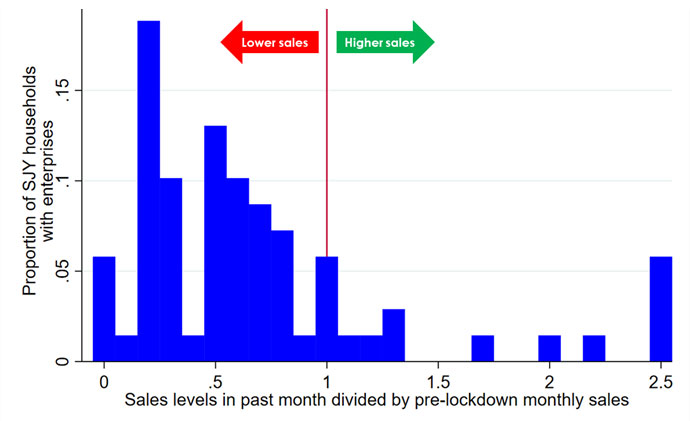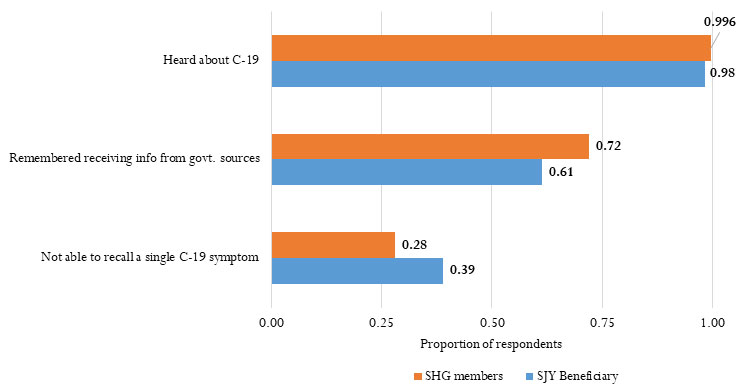Lack of integration into the existing social protection system exacerbates the poor's vulnerabilities, leaving them without adequate support structures during a crisis. In this note, Shagun Sabarwal and Maximillian Lohnert discuss how investing in a livelihood project for the ultra-poor in Bihar proved crucial for extending support as well as spreading awareness when the Covid-19 pandemic hit.
According to the latest estimates, the Covid-19 pandemic will push an additional 88-115 million people into extreme poverty this year. Lack of integration into the existing social protection system exacerbates the poor's vulnerabilities, leaving them without adequate support structures during a crisis. While 70% of India's vast social protection programmes focus on the rural poor, even in pre-pandemic times, these existing systems excluded a substantial proportion of the poor who mostly work in the informal sector.
Recognising these challenges, the state government of Bihar had reworked its social protection architecture in 2018 to include the ‘graduation approach’ to target the poorest of the poor in rural areas. The graduation approach – a tested approach of lifting the poorest out of extreme poverty – is a holistic set of interventions to generate sustainable self-employment activities for the ultra-poor. This typically includes a productive asset grant (either livestock or a small shop), mentoring and enterprise development support, a temporary cash stipend, access to savings accounts, health information, and other government services.
Based on results from a series of rigorous impact evaluations across six countries that showed the graduation approach to be effective in increasing consumption, income, and well-being as well as learnings from two policy pilots in Bihar, the Bihar government decided to scale-up this approach to 100,000 households across all 38 districts in 2018. This scale-up, known as the Satat Jivikoparjan Yojana (SJY)1, is implemented by the Bihar Rural Livelihoods Project (BRLP), locally known as JEEViKA, an autonomous body under the Department of Rural Development.
Leveraging existing databases and mechanisms for Covid-19 response
When the Covid-19 crisis hit Bihar, the SJY was already underway. JEEViKA had identified the most vulnerable households through SJY, and there were 70,000 ultra-poor households in the SJY database. These investments in laying the foundations of the SJY meant that the government had a direct way of knowing who the most vulnerable households were and, more importantly, had a way of reaching them when the crisis hit. Additionally, JEEViKA had already handed over enterprise assets to 35,000 households.
At the outset of the Covid-19 crisis in March 2020, an immediate priority was to raise awareness about how individuals can safeguard themselves and others against the Virus. Due to its consistent involvement with local communities and its existing infrastructure and relationships, JEEViKA facilitated a part of this effort. They leveraged their network of over 1,000,000 self-help groups and community mobilisers. SJY frontline staff (master resource persons) was deployed to raise awareness about Covid-19, its symptoms, and the importance of measures such as social distancing and hand hygiene. JEEViKA used IVR (interactive voice response) messages, leaflets, videos, and a two-part comic series for raising awareness. The SJY also enabled the state government of Bihar to extend immediate relief measures for the poorest. JEEViKA issued an office order to distribute Rs. 2,000 as an emergency consumption stipend to SJY beneficiaries. JEEViKA's official records indicate that they distributed cash stipends to 36,570 SJY households by the end of May 2020, prioritising the SJY households that had not yet received the regular consumption stipends of the SJY.
Awareness activities and relief measures
At J-PAL South Asia, we conducted rapid telephonic surveys to assess the awareness and effects of Covid-19 among 1,010 SJY beneficiaries and SHG members in May and June 20202, and a follow-up survey in August 2020 with SJY beneficiaries who were already running their enterprises. Almost all SJY beneficiaries reported that they had heard about Covid-19, and six out of 10 reported receiving information from government sources. The follow-up survey showed that about half of the beneficiaries were continuously running their enterprises throughout the lockdown. While sales levels were still lower compared to the pre-lockdown period, the self-employment focus of the graduation approach meant that most beneficiaries still had a source of income at a time when other income sources, for example, casual labour, diminished or ceased altogether.
Figure 1. Knowledge of Covid among SJY beneficiaries and SHG members
While these are broadly positive findings, our survey also highlights areas for further action. We find that four out of 10 SJY beneficiaries could not recall a single symptom of Covid-19, and only half of SJY beneficiaries reported regularly washing their hands (despite having access to clean water and soap), and wearing masks as precaution. Overall, SJY beneficiaries were less knowledgeable about Covid-19 symptoms and reported taking precautionary measures less frequently than SHG members. When asked about what coping strategies (if any) they used to meet their basic needs since the beginning of the lockdown, two-thirds of SJY beneficiaries reported reducing the number/size of meals for some household members, a significantly greater proportion than SHG members (53%). More than half (55%) of the SJY beneficiaries had used some of their cash or bank savings, and 42% had taken a loan. In our follow-up survey in August, we found that for those with enterprises, the past month's enterprise sales were, for the vast majority of our sample, lower than in the pre-lockdown period. This indicates that even those who were able to run their enterprise faced income loss when compared to their enterprise income prior to the lockdown.
Figure 2. The last month's enterprise sales compared to pre-lockdown enterprise sales, as reported in August 2020

Note: The horizontal axis gives the ration of past month enterprise sales divided by the average monthly sales prior to the lockdown. The vertical axis shows the proportion of respondents for whom a particular ratio on the horizontal axis applies. For the vast majority of our sample, the sales levels in the past month were lower than what they were in the pre-lockdown period (the sample that is to the left of the red line at 1 on the horizontal axis).
Our findings suggest the importance of continuously spreading awareness about Covid-19 symptoms and precautionary measures beyond the initial 'information push' at the outset of the crisis. It will require the 'mainstreaming' of awareness activities into the daily work of frontline staff. Recognising this, JEEViKA issued an office order asking all District Project Coordination Units (DPCU) to raise awareness about Covid-19 and preventive measures.
It is also vital to ensure that SJY beneficiaries are able to access other government schemes that were announced at the onset of the crisis (convergence with other government schemes is an essential outcome of the SJY). The signs of food insecurity in our survey indicate that enrolling households into the PDS (public distribution system) needs to be a priority. Through its network of ‘Village Organizations’ (VOs), JEEViKA asked community members to make lists of households that they believe are yet to receive ration cards, leveraging VO members' knowledge of vulnerability in their communities. Of the SJY beneficiaries with enterprises, 80% reported that they had accessed the government of Bihar's scheme of one-month free rations for cardholders. All of them had an Aadhaar3 card, an essential prerequisite for accessing various social protection schemes.
The response to the Covid-19 crisis is far from over as the SJY is still addressing challenges arising from the Covid-19 situation. The lockdown restrictions made it challenging to provide in-person support to SJY households regularly, and new SJY frontline staff had to be trained remotely. Furthermore, the crisis has affected the ability of beneficiaries to run and develop their enterprises.
Crucial to ensure that social safety nets include the most vulnerable groups
Despite these challenges in the wake of the pandemic, the SJY clearly shows the benefits of investing in livelihood support for the ultra-poor. There is often no time to set up new social protection schemes and detailed processes for identifying eligible households in times of acute crisis. In this case, JEEViKA had already identified the most vulnerable through the SJY and could use its existing SJY database and infrastructure for outreach. There is a skewed focus on reducing inclusion errors in government schemes in India and not enough efforts to reduce exclusion errors. During crises such as the Covid-19 pandemic, exclusion from the social protection system is even costlier. It exacerbates challenges for disseminating information about Covid-19 and increasing the reach of relief measures. And when information about Covid-19 and relief measures do not reach the groups who need them most, the cycle of vulnerability gets perpetuated. The Covid-19 crisis also highlights the urgent need to build economic resilience among the poor so that they can be protected from any similar shocks in the future. Schemes such as the SJY represent a novel pathway for building strength among vulnerable communities.
As seen from our survey in Bihar, several features of the graduation approach make it a particularly relevant economic inclusion approach in the wake of Covid-19. Its self-employment approach bolsters the household's ability to deal with economic shocks. Its focus on the ultra-poor enables the government and other societal and community institutions to directly link with the most vulnerable through a dedicated cadre of frontline workers that can respond to these households' needs. Governments must provide the poor with access to livelihood opportunities and social protection schemes not only in response to crises but to build resilience among the poor. The graduation approach offers a viable and holistic economic inclusion pathway to help households build resilience even during economic crises.
I4I is now on Telegram. Please click here (@Ideas4India) to subscribe to our channel for quick updates on our content.
Note:
- The ‘Sustainable Livelihoods Promotion Scheme’ was launched with the objective of creating sustainable livelihoods for 100,000 ultra-poor households in Bihar and ensuring they form regular savings habits by participating in JEEViKA’s self-help-groups (SHGs).
- We surveyed SHG members in order to have a roughly comparable group of rural women.
- Aadhaar or Unique Identification (UID) number is a 12-digit identification number linked to an individual’s biometrics (fingerprints, iris, and photographs), issued to Indian residents by the Unique Identification Authority of India (UIDAI) on behalf of the Government of India.
Further Reading
- Banerjee, A, E Duflo and G Sharma (2020), ‘Long-Term Effects of Targeting the Ultra-Poor Program’, NBER Working Paper No. 28074.
- Banerjee, Abhijit, Esther Duflo, Nathanael Goldberg, Dean Karlan, Robert Osei, William Parienté, Jeremy Shapiro, Bram Thuysbaert and Christopher Udry (2015), ‘A multi-faceted program causes lasting progress for the very poor: Evidence from six countries’, Science, 348: 1260799.
- JEEViKA (2020), ‘JEEViKA’s COVID-19 Response Initiatives’, Bihar Rural Livelihoods Promotion Society.
- Rema, H and BA Olken (2020), ‘Cushioning the poor from the COVID-19 shock’, J-PAL (Abdul Latif Jameel Poverty Action Lab), 15 April.
- Sabarwal, S (2020), 'The Graduation Approach during the Covid-19 pandemic: Building resilience among Ultra-poor Households in Bihar', J-PAL (Abdul Latif Jameel Poverty Action Lab).
- World Bank (2020), ‘COVID-19 to Add as Many As 150 Million Extreme Poor by 2021’, 7 October.




 11 December, 2020
11 December, 2020 






Comments will be held for moderation. Your contact information will not be made public.